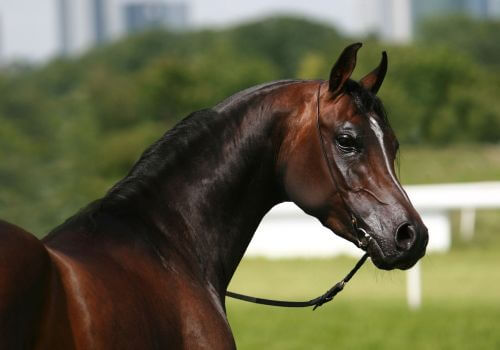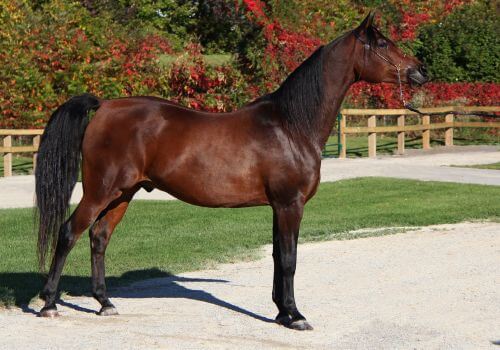The Arabian Horse: The Original Endurance Champion!
- Weight: 800 to 1,000 pounds
- Height: 14 hands (56 inches) to 16 hands (64 inches)
- Body Type: Lithe, compact body; small, wedge-shaped head; dished facial profile, long, arched neck
- Best For: Experienced owners and riders
- Life Expectancy: 25 - 30 years
A Legendary Lineage
The Arabian horse is one of the oldest and most revered horse breeds, with a history dating back thousands of years. Originating from the Arabian Peninsula, these horses were bred by the Bedouin tribes as early as 3000 B.C. for their endurance, agility, and companionship. They have played an essential role in transportation, hauling, and warfare throughout history and have been largely valued due to these numerous contributions to human advancement.

Over time, the breed spread through Europe and beyond due to trade and military conquests. Famous historical figures, including Napoleon Bonaparte, Alexander the Great, and George Washington, favored Arabian horses for their intelligence and loyalty. The breed arrived in the United States in the 1700s, with the Arabian Horse Registry of America established in 1908. Today, Arabians dominate the discipline of endurance riding and are regular competitors across equestrian sports.
What Makes Arabians So Unique?
Arabian horses are renowned for their distinctive appearance, featuring a refined wedge-shaped head, large expressive eyes, arched neck, and high tail carriage. They possess a unique floating gait and smooth ride. Their intelligence, sensitivity, and spirited yet cooperative temperament make them ideal for experienced riders.
How Big is an Arabian Horse?
Arabians are smaller than many modern riding horses, standing between 14 and 16 hands high and weighing 800 to 1,000 pounds. Despite their size, they are incredibly strong and agile, with compact bodies that give them balance and endurance.
Colors and Markings of Arabian Horses
The Arabian Horse Association recognizes bay, gray, chestnut, black, and roan coat colors. Many Arabians also have white facial markings and socks or stockings on their legs. Unlike other breeds, purebred Arabians do not carry dilution genes, so colors such as palomino, buckskin, and dun do not appear in the breed.
What Are Arabians Used For?
Arabian horses are incredibly versatile and excel in multiple disciplines. They dominate long-distance endurance competitions, perform elegantly in dressage, and display impressive speed on the racetrack. Additionally, they are widely used for pleasure riding, show jumping, ranch work, and competitive equestrian sports.

Feeding Your Arabian
A number of basic health issues that commonly affect Arabian horses stem from poor diet and lack of proper exercise, so the Arabian breed requires a well-balanced diet consisting of high-quality hay, grains, fresh water, and occasional fruit and vegetable treats. Their desert ancestry means they often require less feed than other breeds their size to maintain a healthy weight, making careful portion control necessary to ensure they receive adequate nutrition without overfeeding.
As with many other horse breeds, an Arabians exact dietary needs will depend largely on their lifestyle, activity level, and overall health status. Arabian horses participating in endurance events or engaging in rigorous physical activity will need a diet that supports their performance, while an Arabian horse participating in light work or exercise will need much less fuel and fewer calories to sustain their activity.
Poor body condition in the Arabian breed can often be a sign of gastrointestinal and digestive issues, so it's important to work closely with a veterinarian or equine nutritionist if your Arabian's body condition or weight becomes a concern.
Common Health & Behavior Traits of Arabian Horses
Arabian horses are not exempt from their fair share of health concerns. A few of the most common health issues affecting the Arabian breed that horse owners should be aware of include:
- Severe Combined Immunodeficiency (SCID): A genetic disorder where foals are born without an immune system, leading to fatal infections.
- Lavender Foal Syndrome (LFS): A neurological condition causing weakness and lack of coordination, often fatal.
- Cerebellar Abiotrophy (CA): A genetic disorder affecting balance and coordination in foals, typically leading to early euthanasia.
Grooming Your Arabian
Arabians are one of the more low-maintenance breeds when it comes to grooming, but regular grooming activities like brushing, hoof care, and removing loose hair are essential for maintaining an Arabian horse's health and coat condition. Daily brushing distributes natural oils, while a detangler helps keep the mane and tail smooth. Cleaning hooves daily prevents infections and injuries, and routine veterinary checkups ensure overall well-being.
An often overlooked aspect of caring for Arabian horses is the need for regular dental care and cleaning. The Arabian horse's anatomy predisposes them to dental complications that will need regular monitoring from equine dental professionals. Most notably, Arabians can often suffer from overcrowded teeth due to their small head size. Regular dental care can ensure that any dental diseases or issues are identified in a timely manner before they can negatively impact the horse's health or comfort.
Saddling Up Our Final Thoughts
The Arabian horse is often called the most beautiful horse in the world, and for good reason. With their striking looks, exceptional endurance, and intelligence, Arabians continue to be a favorite among equestrians worldwide. Whether as a companion, competitor, or historical icon, the Arabian horse remains one of the most cherished breeds.
